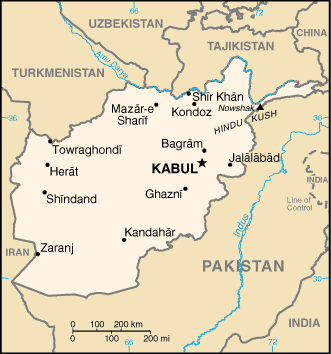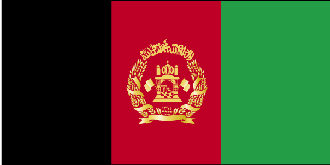
|
Afghanistan
Background:
Afghanistan's recent history is characterized by war and civil unrest. The
Soviet Union invaded in 1979, but was forced to withdraw 10 years later by
anti-Communist mujahidin forces supplied and trained by the US, Saudi Arabia,
Pakistan, and others. Fighting subsequently continued among the various
mujahidin factions, giving rise to a state of warlordism that eventually
spawned the Taliban. Backed by foreign sponsors, the Taliban developed as a
political force and eventually seized power. The Taliban were able to capture
most of the country, aside from Northern Alliance strongholds primarily in the
northeast, until US and allied military action in support of the opposition
following the 11 September 2001 terrorist attacks forced the group's downfall.
Location:
Southern Asia, north and west of Pakistan, east of Iran.
Area: total: 647,500 sq km water: 0 sq km land: 647,500 sq km.
Area - comparative: slightly smaller than Texas.
Land boundaries: total: 5,529 km border countries: China 76 km, Iran 936 km,
Pakistan 2,430 km, Tajikistan 1,206 km, Turkmenistan 744 km, Uzbekistan 137 km
Coastline: 0 km (landlocked).
Climate and Terrain:
Climate: arid to semiarid; cold winters and hot summers.
Terrain: mostly rugged mountains; plains in north and southwest.
Natural resources: natural gas, petroleum, coal, copper, chromite, talc,
barites, sulfur, lead, zinc, iron ore, salt, precious and semiprecious stones.
People:
Population: 28,717,213.
Ethnic groups: Pashtun 44%, Tajik 25%, Hazara 10%, minor ethnic groups (Aimaks,
Turkmen, Baloch, and others) 13%, Uzbek 8%.
Religions: Sunni Muslim 84%, Shi'a Muslim 15%, other 1%.
Languages: Pashtu 35%, Afghan Persian (Dari) 50%, Turkic languages (primarily
Uzbek and Turkmen) 11%, 30 minor languages (primarily Balochi and Pashai) 4%,
much bilingualism.
Government:
Government type: transitional
Capital: Kabul
Economy overview:
Afghanistan is an extremely poor, landlocked country,
highly dependent on foreign aid, farming and livestock raising (sheep and
goats), and trade with neighboring countries. Economic considerations have
played second fiddle to political and military upheavals during more than two
decades of war, including the nearly 10-year Soviet military occupation (which
ended 15 February 1989). During that conflict, one-third of the population fled
the country, with Pakistan and Iran sheltering a combined peak of 4 to 6
million refugees. Gross domestic product has fallen substantially over the past
20 years because of the loss of labor and capital and the disruption of trade
and transport; severe drought added to the nation's difficulties in 1998-2002.
Statistics:
Telephones - main lines in use: 29,000.
Radio broadcast stations: AM 7.
Radios: 167,000.
Television broadcast stations: at least 10.
Televisions: 100,000.
Railways: total: 24.6 km.
Highways: total: 21,000 km paved: 2,793 km unpaved: 18,207 km.
Airports: 47.
Airports - with paved runways: total: 10,
with unpaved runways: total: 37.
Heliports: 5.
Return to Visiting Locations
|

